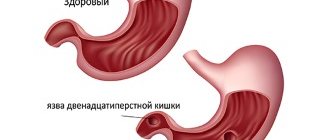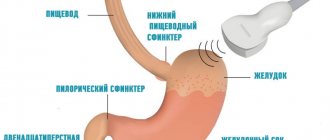What is an ulcer: classification and types of disease
An ulcer is a chronic disease characterized by a targeted violation of the integrity of the wall of a diseased organ.
Unlike erosions, the ulcer penetrates the submucosal layer. Peptic ulcer disease is classified according to several criteria.
Location of the pathology. The following types are distinguished:
- damage to the duodenal bulb;
- ulceration of the postbulbar region;
- damage to the fundus of the stomach;
- combined pathology.
Depth of damage. There are three types:
- superficial defects, only the mucous membrane is damaged;
- deep, involving the serous membrane and muscle tissue;
- through (perforation).
Flow form. Diagnose:
- uncomplicated course;
- complicated, accompanied by bleeding;
- pyloric stenosis;
- penetrating ulcer (penetrates into neighboring organs);
- ulcer complicated by adhesions (perivisceritis).
information Ulcers are also distinguished by the stage of their course (acute or chronic), the size of the defect, functional characteristics (degree of acidity, increased or decreased motility) and other characteristics.
General information
Gastric ulcer is a rare extragenital pathology detected in 0.025% of pregnant women. These statistical indicators may be somewhat underestimated due to the difficulties of diagnosing the disease during gestation. Currently, the prevalence of gastric ulcer in the female population as a whole is 8-11%, with a trend towards an increase in incidence. Most likely, this is due to increasing stress loads, high social activity, and family instability. Thanks to the use of modern methods of eradication therapy for Helicobacter pylori, a bacterium associated with gastric ulcers, the number of complicated forms of the disease has significantly decreased.
Pathogenesis
The mechanism of ulceration of the gastric mucosa is based on the occurrence of an imbalance between aggressive and protective factors. The damaging effect is provoked by enzymes secreted by Helicobacter bacteria. Under the influence of urease, urea is converted into ammonia, which neutralizes the acidity of the stomach. In response to alkalization, the secretion of gastrin, hydrochloric acid, and pepsin increases, and the production of bicarbonates is inhibited. Microbial phospholipase, mucinase, protease depolymerize and dissolve gastric mucus, opening access to mucous hydrochloric acid and pepsin. As a result of a chemical burn and an inflammatory reaction, an ulcer is formed. The destruction of the epithelium is enhanced by vacuolization of cells under the influence of the endotoxin VacA, the release of lysosomal enzymes, interleukins and other inflammatory mediators.
In 75-80% of pregnant women, destructive processes in the gastric mucosa slow down and remission of the disease occurs, which is associated with increased secretion of protective mucus under the influence of progesterone, accelerated epithelial regeneration and improved blood supply to the gastroduodenal area due to estrogen stimulation, and a temporary decrease in the secretion of hydrochloric acid. The indirect effect of activation of the parasympathetic system is the normalization of the motor-evacuation function of the stomach with a shortening of the contact time between aggressive factors and epithelial cells.
Treatment of stomach ulcers in pregnant women
Therapeutic tactics in patients with acute peptic ulcer disease are aimed at reducing gastric acidity, relieving pain and erosive processes. Non-drug treatment includes the appointment of therapeutic and protective ward or bed rest, drinking alkaline mineral waters, diet therapy with frequent split meals and restriction of foods that stimulate gastric secretion or have a mechanical, thermal, chemical damaging effect on the gastric epithelium. The following medications are used to treat pregnant women:
- Non-absorbable antacids
. The therapeutic effect of antacid drugs is associated with a decrease in the acidity of gastric juice to a physiological level due to the binding of hydrochloric acid, protective coating of the mucous membrane, and a decrease in the proteolytic activity of pepsin. Due to the lack of alkalizing effect, antacids do not interfere with the digestion of food. - Sorbents based on diosmectite
. Although enterosorbents do not affect the secretion of hydrochloric acid, they have a pronounced gastroprotective effect by increasing mucus secretion, strengthening the glycoprotein matrix, and adsorption of toxins produced by Helicobacter. Diosmectites are not absorbed by mucous membranes, are excreted unchanged and are safe for the fetus. - H2-histamine receptor blockers
. Use in pregnant women is limited when antacid therapy is ineffective. They have a pronounced antisecretory and protective effect: they suppress the secretion of pepsin and hydrochloric acid, enhance the synthesis of prostaglandins, and the secretion of bicarbonates. Capable of improving local microcirculation and accelerating ulcer regeneration. - Myotropic antispasmodics
. Indicated in case of pain associated with impaired gastric motility. They relax spasmodic smooth muscle fibers and thereby quickly eliminate an attack of pain. To enhance the effect, they can be prescribed in combination with prokinetics, which improve accommodation of the fundus of the stomach and normalize gastrointestinal motility.
To improve digestion and eliminate flatulence, it is possible to prescribe medications containing enzymes. Bismuth preparations, proton pump inhibitors and other agents for the eradication of Helicobacter pylori are not prescribed to pregnant women due to possible toxic effects on the fetus. Surgical interventions are performed only if complications occur (bleeding, perforation, penetration). Patients with gastric ulcers are advised to give birth naturally under epidural anesthesia. Caesarean section is performed only if there are obstetric indications or severe concomitant pathology.
Causes of ulcer development
It has been noticed that peptic ulcer almost always occurs against the background of gastritis. This is not surprising, because each of these diseases has the same cause of origin. The direct culprit in the development of ulcers is Helicobacter pylori. These bacteria live in the digestive tract of almost every person, but only in some of them does infection lead to peptic ulcers. What is the reason for this feature of the disease?
There are several factors that provoke the appearance of ulcers:
- heredity;
- stress and increased anxiety;
- nutritional features;
- taking medications (glucocorticosteroids, NSAIDs and others);
- bad habits (smoking and addiction to alcohol).
Any of these factors are thought to increase a person's risk of developing peptic ulcers. This disrupts the balance of the stomach environment and increases the production of aggressive hydrochloric acid. An ulcer occurs - a defect in the inner lining of the stomach. On the mucous membrane of the duodenum, an ulcer is formed by the same mechanisms as in the stomach.
Causes
Typically, the disease occurs before gestation and is caused by a combination of several factors - hereditary predisposition, provoking endogenous and exogenous influences. The immediate cause of the formation of ulcers is the damaging effect of hydrochloric acid on the gastric epithelium. Additional contributing factors are:
- Helicobacter pylori infection
. An important role in the development of pathology is played by the contamination of the gastric mucosa with the acid-fast spiral-shaped bacterium Helicobacter pylori, detected in 38% of pregnant women suffering from peptic ulcers. At the same time, in recent years the number of patients with HP-negative gastric ulcers has been increasing. - Genetic determination
. A local mucosal defect occurs more often in predisposed pregnant women. The genetic marker of the disease is blood type 0 (I), which is usually associated with hyperplasia of parietal cells that produce hydrochloric acid. Hereditary nature also has an increase in the serum concentration of pepsinogen-1, acetylcholine, cholinesterase, an increase in the number of antral G-cells producing gastrin, a low content of fucoglycoproteins in gastric mucus, the presence of HLA-B5, B15, B35 and other histocompatibility antigens, the inability of the mucous membrane to secrete glycoproteins . - Damage to the mucous membrane.
Factors that provoke ulceration of the gastric mucosa in pregnant women are smoking, consumption of large quantities of strong alcohol, caffeine-containing drinks, unsystematic nutrition, uncontrolled intake of NSAIDs, sulfonamides and a number of antibacterial drugs, violation of the integrity of the epithelium by foreign bodies. In rare cases, an ulcer develops against the background of diabetes mellitus, leiomyoma, adenocarcinoma, carcinoid, germination of malignant tumors of other gastrointestinal organs, Crohn's disease, lymphoma, sarcoma, HIV infection, syphilis, tuberculosis.
Although pregnancy usually has a beneficial effect on the course of peptic ulcer disease, in 10% of patients the disease worsens. Most likely, this is caused by increased gastric secretion in the first trimester due to a physiological increase in the tone of the vagus nerve. A possible role in the exacerbation of peptic ulcers 2-4 weeks before the end of the gestational period is played by a stressful condition caused by fear of the upcoming birth. Increased symptoms after childbirth are due to a decrease in the protective effect of progesterone and estrogens against the backdrop of significant stress and often dietary disturbances.
Symptoms and signs of the disease
An ulcer during pregnancy can be treated if diagnosed in a timely manner. The problem is that the pathology in the expectant mother is often asymptomatic. Many pregnant women mistake discomfort for toxicosis.
A woman should consult a gastroenterologist with the following signs of the disease:
- prolonged early toxicosis is accompanied by severe vomiting and increased salivation up to 20, sometimes subsequent weeks of pregnancy;
- a feeling of hunger along with a nagging or bursting pain in the stomach, night “hunger” pains are not uncommon;
- in different trimesters, the nature, intensity, and localization of pain changes. A more acute course of the disease is observed in the 1st trimester and shortly before childbirth; pain can be felt in the interscapular area;
- in the 2nd and 3rd trimesters, heartburn and sour belching develop;
- disturbance of intestinal motility, stool becomes black;
- dizziness, nausea in later stages.
Stomach bleeding, including hidden bleeding, poses a danger. Manifested by vomiting mixed with blood. The condition requires immediate hospitalization.
information Exacerbation of the disease is typical for the spring and autumn period, the 1st trimester, the last two weeks before childbirth and the first two after the birth of the baby. More often, ulcers occur in representatives of blood group 1.
Symptoms of peptic ulcer in pregnant women
Attacks of ulcers occur in expectant mothers, as in ordinary people, in the spring or autumn. The most common symptoms are:
- sharp pain in the stomach that appears a certain time after eating;
- nausea and vomiting;
- heartburn;
- sour belching;
- constipation
Throughout pregnancy, a woman must be observed by a gastroenterologist. And if any of the above symptoms appear, you should consult a doctor to avoid worsening the situation.
Symptoms of stomach ulcers in pregnant women
Since most patients experience spontaneous remission, peptic ulcer disease during gestation is usually asymptomatic. During an exacerbation, a pregnant woman complains of discomfort, a feeling of heaviness, pain in the epigastrium, which occurs, depending on the location of the ulcer, immediately after eating or 30 minutes to 1 hour later. Pain may radiate to the left scapula, precordial region, thoracic, lumbar spine. Some women note the appearance of sour belching, nausea, bloating, constipation, and less commonly, vomiting, which brings relief. Due to digestive disorders accompanying ulcers, weight gain in pregnant women often slows down.
Complications of stomach ulcers
The lack of adequate treatment for gastric ulcers in pregnant women threatens with serious complications for both the mother and the fetus.
- The most serious complication is gastrointestinal bleeding. It is characterized by the appearance of vomit the color of coffee grounds streaked with blood. If this complication occurs, the pregnant woman must be urgently taken to the doctors.
- Perforation. This condition causes severe, cutting pain in the stomach. Blood pressure drops quickly and pulse quickens. Without treatment, perforation of the ulcer turns into peritonitis, which can be fatal, so in this case, immediate help from specialists is necessary.
- Frequent nausea and vomiting leads to loss of iron and vitamins, which negatively affects the health of the woman and the fetus.
- Peptic ulcer disease is often accompanied by the development of iron deficiency anemia. In this case, placental insufficiency and hypoxia develop in the fetus.
Symptoms of emergency conditions
To prevent serious consequences for the woman and child, it is necessary to immediately contact an ambulance if symptoms of emergency conditions are detected.
These include vomiting and diarrhea that are not stopped by medications, as well as when there is blood in the vomit or feces. Acute abdominal pain and tremors in the limbs also require emergency treatment.
Other symptoms of acute conditions include increased blood pressure due to pain, high body temperature, and clouding of consciousness. Timely assistance can not only alleviate the condition of the fetus and the woman, but also save her from miscarriage and other deadly conditions.
Diagnostics
FGDS (fibrogastroduodenoscopy) in pregnant women is performed only when complications of an ulcer develop. In other situations, doctors make a diagnosis based on typical symptoms and examination data. An endoscopic examination can provoke an increase in uterine tone, so if possible, doctors try to avoid this manipulation.
X-ray contrast examination of the digestive tract during gestation is also not performed. If necessary, the doctor can perform an ultrasound of the stomach and evaluate its size, as well as its functioning features. It is not possible to detect ulcerative defects with ultrasound.
How to cure stomach ulcers during pregnancy
Gastric ulcer in pregnant women
is a chronic recurrent disease identified during gestation, in which a local ulcerative defect is formed in the gastric mucosa. It manifests itself as epigastric pain, discomfort, heaviness in the epigastric region, dyspeptic symptoms, and slower weight gain. It is diagnosed using ultrasound of the stomach, gastroscopy, laboratory methods for detecting helicobacteriosis, supplemented by pH-metry and stool analysis for occult blood. For treatment, antacids, enterosorbents, selective histamine blockers, and myotropic antispasmodics are used.
Features of diagnosing ulcers during pregnancy
To diagnose an exacerbation of a peptic ulcer, along with an analysis of the patient’s complaints, clinical symptoms identified by the therapist during examination, it is necessary to conduct additional clinical and instrumental examinations, which safely and with minimal stress on the woman’s body will allow a more accurate diagnosis, prevent complications and prescribe appropriate therapy.
- To exclude hidden bleeding, it is recommended to periodically (if there are relevant complaints) conduct a stool test for hidden blood, and in a general blood test, monitor the dynamics of changes in the number of red blood cells, hemoglobin and hematocrit. You should also determine serum iron levels and trace element levels at least twice during pregnancy.
- It is difficult to overestimate the importance of such a research method as FGDS (esophagogastroduodenoscopy), which is usually well tolerated by patients who have experience of undergoing this procedure multiple times. In this case, it is possible to identify an ulcer with an assessment of its size and condition, the stage of the process (“fresh”, scarring, etc.), the presence of complications (bleeding, cicatricial deformation with stenotic phenomena, etc.). Also, this study reveals signs of reflux esophagitis (reflux of gastric contents into the esophagus), insufficiency of the gastroesophageal sphincter, the presence of diaphragmatic hernias, hypersecretion of gastric contents with taking it for analysis)
- Ultrasound examination of the abdominal organs is also of great help. It allows you to non-traumaticly determine the state of gastric motility and hypersecretion, conduct a differential diagnosis of cholelithiasis, gallbladder dyskinesia and exacerbation of duodenal bulb ulcers, which often give similar symptoms and localization of pain in the right hypochondrium.
Treatment of ulcers during pregnancy
During pregnancy, it is unacceptable to self-medicate. The doctor carries out therapy for peptic ulcer disease based on the results of laboratory tests and examination, including ultrasound of the abdominal cavity and gastroscopy. The pregnant woman will be offered hospital treatment. First of all, bed rest is necessary.
The patient is prescribed:
- diet No. 1 or 1b according to Pevzner. Very hot and very cold foods are excluded from the menu, dishes that irritate the mucous membrane and stimulate secretory function are prohibited;
- medicinal mineral water (for example, “Essentuki” No. 14);
- fractional meals in small portions up to 6 times a day;
- herbal medicine: various stomach preparations (calamus rhizomes, chamomile, dill seeds, peppermint leaves).
What can you do
- If a pregnant woman discovers signs of prolonged toxicosis, she should definitely bring them to the attention of her obstetrician-gynecologist. Prolonged toxicosis is no longer toxicosis, but something more serious.
- A girl who is in an “interesting” situation must unquestioningly follow all the instructions voiced by the doctor. All advice must be followed.
- The expectant mother should begin to normalize her diet, which will be based on the following rules: small meals, frequent meals, saturation of the diet with vitamins and microelements.
What can a doctor do?
The doctor usually prescribes the following set of therapeutic measures for stomach ulcers:
- Fractional meals. Meals must be divided into small portions, and their quantity increased to 5-6 times;
- Mandatory bed rest;
- Lack of physical activity;
- Taking gentle antacids and astringents (decoctions of chamomile, St. John's wort, etc.);
- If there is severe pain, antispasmodic drugs are prescribed;
- Dieting.
Medications
Table of medicines.
| Antacids | Astringents | Antispasmodics |
| Gaviscon is a suspension for oral administration. Active ingredients: sodium alginate, sodium bicarbonate, calcium carbonate. Prescribed for the treatment of stomach ulcers in pregnant women. | Vikair is a combination drug. It has an astringent, laxative, bactericidal and antispasmodic effect. Can be used to treat pregnant women. | Duspatalin - gelatin capsules. The active ingredient is mebeverine hydrochloride. Has a direct effect on the smooth muscles of the gastrointestinal tract. Eliminates spasm. Can be used in pregnant women. |
| Maalox - chewable tablets. Active ingredients: alhydrate, magnesium hydroxide. Indicated for the treatment of peptic ulcers, including in pregnant women. | No-shpa - yellow tablets. The active ingredient is drotaverine hydrochloride. Indicated to eliminate spasm of smooth muscles of the gastrointestinal tract during peptic ulcer disease. Can be prescribed to pregnant women. |
What an ulcer!
The scientist tested it on himself
It turned out that ulcers are an infectious disease, and one of the most common on Earth.
The bacterium that causes it is found in the stomachs of more than half the world's population. Its prevalence directly depends on the level of socio-economic development: in developed countries it is less (30-40%) than in third world countries, where almost everyone is susceptible to infection (up to 90%). The hereditary nature of the disease can also be traced, and in each subsequent generation the disease begins at a younger age and is more severe. Scientists back in the 19th century suspected that gastritis and peptic ulcers were contagious, but it was only recently that the “culprit” was identified. In 1982, Australian researchers Barry Marshall and Robin Warren discovered the bacterium Helicobacter pylori and, after carefully studying its effects on the gastric mucosa, suggested that it causes peptic ulcers. To prove his theory, Barry Marshall even repeated the feat of Louis Pasteur and conducted a self-infection experiment on himself - he drank a Helicobacter culture. Two weeks later, the young scientist fell ill with severe gastritis and had a long and difficult recovery. But the bacterial nature of peptic ulcer has been proven.
Today, doctors confidently claim that 90% of all cases of duodenal ulcers and up to 80% of cases of stomach ulcers are caused by Helicobacter pylori. The remaining 10-20% is usually associated with long-term use of non-steroidal anti-inflammatory drugs such as aspirin or ibuprofen. Stress, spicy food, smoking, alcohol, carbonated drinks and other harmful factors only worsen the patient’s condition, but do not cause an ulcer on their own.
The discovery of Australian scientists radically changed the approach to treatment. Previously, the emphasis was on diet, but now it is obvious that an ulcer is not a chronic disease, but a disease that can be cured by taking antibiotics. As a result, even with advanced peptic ulcer disease, many patients manage to avoid surgery. The incidence of stomach cancer, which, as it turned out, is caused by the same bacterium, has also decreased.
Evil bacteria
The food you eat enters the stomach through the esophagus, where it mixes with gastric juice containing digestive enzymes and hydrochloric acid. Helicobacter - almost the only bacterium that is not destroyed by gastric juice - burrows into the gastric mucosa, disrupting the structure of its tissues and their functions. This potentially leads to inflammation of the gastric mucosa (gastritis), erosions and ulcers.
With weakened immunity and long-term existence in the body, Helicobacter pylori can spread both to the overlying parts of the stomach and to the duodenal bulb.
Pale, nervous, sad
This is a portrait of a man suffering from peptic ulcer disease. He suffers from heartburn, nausea, sometimes vomiting, and pain in the stomach. It may worsen between meals, after meals - immediately or after 2-3 hours.
Most often, the pain occurs in the epigastric region, but can radiate under the shoulder blade, to the left side of the sternum (which is why they are often mistaken for heart pain), felt like a feeling of fullness in the stomach, heaviness in the abdomen, or reminiscent of hunger. It is enough to drink sour juice, coffee, alcohol, or take an aspirin tablet to make the pain worse. Antacids or food help relieve discomfort. However, after some time the torment resumes.
And since digestion is disrupted during a peptic ulcer, the intestines also suffer. Belching and heartburn begin. Due to poor absorption of food, iron deficiency in the body and anemia (anemia) develop: a person feels constant fatigue and lethargy. Overall health weakens and immunity decreases.
Dangerous Kiss
The infection usually affects the lower part of the stomach in early childhood and “lives” in it for many years. The main source of peptic ulcer disease is an infected person. You can become infected through everyday contact: it is believed that most often an infant receives the bacteria from an infected mother. It is possible that the bacterium enters the stomach through food and drink. You can catch Helicobacter through shared bed linen, towels, dishes, a handshake and a kiss. So be careful even with those who have “mild gastritis”. Under no circumstances should you lick the spoons you use to stir food. It is unacceptable to put baby pacifiers in your mouth.
City dwellers suffer from stomach and duodenal ulcers 2 times more often than rural residents, and men (and often young ones) are 3-4 times more likely than women. Smokers and drinkers are more at risk. As a rule, ulcers worsen in autumn and spring, when immunity is impaired. Helicobacter, like other bacteria, prefers weakened people. Especially irritable: when a person is nervous, his stomach produces more hydrochloric acid than normal. And for the ulcer bacillus this is the most suitable environment. In it, she rapidly multiplies.
Don't launch!
Thanks to new approaches, 95% of cases of peptic ulcer disease can be treated, and the number of complications such as ulcer perforation and ulcer bleeding is reduced by up to 10 times. Today, in the treatment of this disease, in addition to antacid, astringent, enveloping, antispasmodic drugs, antibiotics and other medications of the latest generation are used. They must be taken in a course, without breaks, otherwise the bacteria will remain undefeated and the ulcer cannot be cured. Don't self-medicate!
In advanced forms, large ulcers may develop that do not heal for a long time and are not amenable to conservative treatment. And then an operation is needed to remove part of the stomach.
Unfortunately, our country has a lowly leading position in the world in the number of operations for complicated peptic ulcer disease. This is due to the lack of general sanitary culture of the population and the low standard of living. Our people often neglect the disease, try to be treated with “grandmother’s remedies” and end up in the hospital in a very serious condition, when it is no longer just treatment that is required, but the saving of their lives.
Can't do without a diet
If you have a stomach ulcer, it is advisable to completely eliminate certain foods from your diet. First of all... milk. Although it was once believed that a glass of milk was enough to relieve pain during an exacerbation of an ulcer. Alas, this was a misleading idea, because milk, as doctors have found, increases the amount of stomach acids, rather than neutralizing them. In addition, any hot and spicy food is included in the list of prohibited foods for stomach ulcers - it increases pain by irritating the tissue of already formed ulcers on the walls of the stomach. You will have to give up rich meat, mushroom, fish broths, fried, pickled, canned, sour foods and black bread. Coffee, alcohol and soda are also excluded - their digestion requires a large amount of stomach acids, and their formation provokes the occurrence of peptic ulcers.
Smoking on an empty stomach is generally harmful, but with ulcers and gastritis it is simply dangerous. Chewing gum is no less harmful - especially on an empty stomach, it provokes the release of hydrochloric acid, gastric juice... But since the food has not arrived, the stomach will begin to digest its own mucous membrane. For the same reason, fasting is extremely harmful. You need to eat little by little, but 4-5 times a day. It is useful to drink a glass of mineral water half an hour before meals. Mucous decoctions help, especially jelly, porridge - oatmeal, rice.
Specifically
Who needs to be tested for Helicobacter pylori
Any of the following symptoms of “stomach malaise” should be a reason to visit a gastroenterologist or therapist:
- recurring pain in the stomach, especially after eating (a sign of erosions and ulcers),
- the appearance or worsening of heartburn,
- feeling of heaviness in the stomach,
- aversion to meat food (even to the point of vomiting).
- And remember: 95% of cases of peptic ulcer can be treated.
Nutrition for illness
After confirmation of the diagnosis, all women must follow a special diet. Despite the fact that pregnancy is traditionally considered a period in which some indulgences, quirks and liberties in the diet are acceptable, in the case of a peptic ulcer it is better not to take risks. A stomach ulcer requires regular compliance with all dietary recommendations: this allows you not to irritate the mucous membrane and reduce the severity of pain. Often, pain syndrome forces a woman to refuse food altogether: however, such behavior will harm the baby even more.
During an exacerbation, experts advise eating more cereals, slimy soups, jellies and purees: crushed food does not irritate the stomach. Gradually, you can add soft steamed chicken or fish cutlets, pasta, and thermally processed vegetables to your diet. Such nutrition will allow you to maintain long-term remission. It is also recommended to drink at least 2 liters of water daily.
Treatment methods
As with any diseases of the digestive tract, special attention is paid to diet in the treatment of peptic ulcers. Without a significant change in diet, no therapy will bring the desired effect. How should pregnant women eat to prevent the progression of ulcers?
Dietary recommendations for peptic ulcers:
- Meals should be frequent: 5-6 times a day with a break of 3-4 hours.
- It is recommended to reduce the usual portion of food by 1.5-2 times (taking into account the increase in the frequency of meals).
- All dishes are boiled, steamed or baked in the oven.
- Fried foods are excluded.
- Salt is limited to 5 g per day.
- It is not recommended to eat foods that are too cold or hot.
Products allowed for peptic ulcers:
- stale bread, unhealthy cookies;
- vegetable and dairy soups;
- lean meat;
- chicken;
- River fish;
- cereals and pasta;
- milk and fermented milk products;
- non-acidic juices (berry, fruit, vegetable).
Products prohibited for peptic ulcers:
- fresh bread and pastries;
- fat meat;
- sea fish;
- soups with meat and fish broths;
- hot and spicy dishes;
- salty dishes, marinades;
- smoked products;
- canned food;
- sour fruits and berries (as well as juices from them);
- carbonated drinks;
- alcohol.
Prognosis and prevention
In most pregnant women, gestation contributes to the onset of remission. In case of exacerbation of the disease, adequate antacid therapy allows pain to be relieved in 3-5 days, and lasting improvement can be achieved in 2-3 weeks of hospital treatment. To prevent recurrence of ulcers on the eve of childbirth and in the postpartum period, patients with a history of peptic ulcer disease or who have experienced an exacerbation in this pregnancy are recommended to take prophylactic antacids and enterosorbents at 37-38 weeks of gestation. Primary prevention of the disease involves quitting smoking, alcohol, normalizing diet and nutrition, adequate rest, and avoiding stress.
Sources
- https://baby-calendar.ru/zabolevaniya/yazva/
- https://www.KrasotaiMedicina.ru/diseases/zabolevanija_gynaecology/gastric-ulcer-pregnancy
- https://spuzom.com/yazva-pri-beremennosti.html
- https://1zhkt.ru/yazva/zheludka-pri-beremennosti.html
- https://mbdou20-sakh.ru/pervye-priznaki-beremennosti/yazvennaya-bolezn-i-beremennost-prichiny-simptomy-i-lechenie
- https://vitaportal.ru/medicine/pischevaritelnaya-sistema-i-zabolevaniya-zhkt/yazva-pri-beremennosti-opasna-no-nezametna.h
- https://DetStrana.ru/service/disease/pregnant/yazva-dvenadtsatiperstnoj-kishki/
- https://TvoyZheludok.ru/yazva/drugoe/yazva-zheludka-pri-beremennosti.html
- https://MedAboutMe.ru/mat-i-ditya/publikacii/stati/beremennost_i_rody/yazva_zheludka_u_beremennoy_simptomy_i_terapiya/
[collapse]
Previous article: Acute pancreatitis - causes, symptoms, diagnosis and treatment Next article: Stomach ulcer: symptoms and treatment in adults, manifestations of complications











